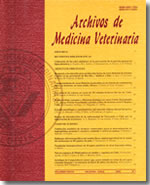Superficial digital flexor tendon tendinopathy and suspensory ligament desmopathy in horses: pathophysiology and regenerative therapies
Main Article Content
Abstract
Tendon and ligament injuries are frequent in horses. The superficial digital flexor tendon (SDFT) and the suspensory ligament (SL) are the most frequently affected structures. The clinical form of these pathologies is generally chronic and degenerative. The treatments commonly used do not result in a definitive cure of the problem and most of the patients relapse or do not recover their initial athletic capacity. Advances in molecular pathophysiology of tendonitis and desmitis in man, horses and other animals have shown the presence of catabolic cytokines, which are possibly responsible for the general dysfunction observed in these pathologies. The current objectives of the treatments of these problems are the regeneration and not the repair (scar formation) of the injured tissue. In the horse, novel experimental and clinical treatments have been described. These treatments include the injection of bone marrow aspirates, mesenchymal stem cells, recombinant growth factors such as insulin-like and platelet rich plasma (also termed autologous platelet concentrates), amongst others. The observed results have been promising when these novel therapies were used. However, just as with other treatments, further research is needed to demonstrate that its clinical use can be effective and safe in horses.

